Nippon: Won! (with Summary and Rating)
Nippon: Won! (with Summary and Rating) - Hallo Guyst Review Games Update, In the article you read this time with the title Nippon: Won! (with Summary and Rating), we have prepared this article well for you to read and take information in it. hopefully the post content what we write can you understand. alright, happy reading.
Title : Nippon: Won! (with Summary and Rating)
link : Nippon: Won! (with Summary and Rating)
The size of the game pushed the limits of the Commodore 64. I noted in a previous entry that the city of Ulti-Tori is shaped like Sosaria from Ultima III, but what I don't think I made clear is that it's also the same size as Sosaria; the entirety of Ultima III's outer world fit into one of Nippon's 40 cities. The game used all available 64kb of memory. To make such a large outer world possible, the disks are not organized into files but read block-by-block, which can cause some amusing errors if you put the wrong disk in the drive while traveling.
You are now reading the articlel Nippon: Won! (with Summary and Rating) with link address https://reviewgameupdate.blogspot.com/2018/03/nippon-won-with-summary-and-rating.html
Title : Nippon: Won! (with Summary and Rating)
link : Nippon: Won! (with Summary and Rating)
Nippon: Won! (with Summary and Rating)
 |
| The PC arrives home at last. |
Nippon
Germany
Independently developed; published by Markt & Technik
Released in 1988 for Commodore 64
Date Started: 26 February 2018
Date Ended: 21 March 2018
Total Hours: 31
Difficulty: Moderate (3/5)
Final Rating: 32
Ranking at time of posting: 177/290 (61%)
Since my first entry on Nippon, we seem to have reached consensus that the "final version" of the story presented at the Nippon Museum web site is the one that the players of 1988 read. It's worth reviewing that backstory as we contemplate the end of the game. It concerns an overworked, directionless Tokyo professional named Toshiro who becomes fascinated by the account of a fantasy world called Nippon that he finds in a local bookstore. The account is written by a man named Shimo from the modern world who suddenly finds himself in this faraway place. Taken in by a kind man named Kamisori, the protagonist at first denies the reality of what he's experiencing, but then comes to accept it as he travels the land and fights monsters. The account describes a bit about the land's history and geography as well as some of the items and skills the player may find in the game. Unable to find his way home, Shimo writes a book about his adventures and tosses it into the abyss at the edge of the world, musing that "maybe these words are to be found once in the old bookstore, which stood in a side street of Tokyo, in which everything began."
While speaking to one of Nippon's residents, Shimo tells him of statues of a king and queen that he saw at a Tokyo museum. His companion recognizes the descriptions as Emperor Tenno Subarashii and his princess, Kikori Shiramoto. The princess was miserable and disappeared a few hundred years ago. Toshiro, reading the account, is excited to see the statues for himself. He heads down to the museum, walks between a couple of columns, and wakes up next to a river in Nippon. The implication is of course that Shimo is actually Toshiro and that he was reading his own account of his visit.
If I'd realized that the other stories presented on the site didn't have much of an impact on the game, I wouldn't have been quite as confused as to its plot. The earlier ones put much more emphasis on the emperor and princess and their doomed marriage, with the implication that the princess somehow made her way to the real world and instigated Toshiro's trip. As he stands looking at the statues in Version 1, for instance, an old woman, whose eyes look like the princess's, grabs his arm and says: "You have to go back, you must! Start again, find it! You were so close, and everything is coming back! Find it, and then I too am free!"
Spine-tingling words, and a great way to begin a story. Version 2 mostly tells a longer version of Version 1; Version 3 somewhat unites 1/2 with the "final version," making it clear for the first time that Nippon is another land and not just ancient Japan. But in the final text, the emperor and princess are de-emphasized, and no old woman appears when Toshiro begins his journey. The story is more focused on the cyclical and pre-determinate nature of Toshiro's experience.
Thus, the main goal of Nippon is simply to return back to Tokyo. To do so, the player first has to accumulate the weapons, armor, items, and skills necessary to survive and navigate in a hostile world. He then has to travel the enormous landscape (at 1024 x 640, the largest we've seen by 1988), visit the towns and castles, and collect the clues necessary to find his way home. Chief among them are the key dates at which the six mountains of "Nippon" can be consecrated. He must use the Wheel of Time to visit the mountains on those dates, then pray at a couple of temples to find his way out. The final portal won't let him leave if he hasn't visited all the Buddhas and (I think) achieved the combat rank of "shogun."
Most of the spells and items are superfluous. It turned out that in addition to the "magic" skill, I also needed a spellbook in which to record the spells I found. But even once I found the book, I didn't bother to collect all the spells. There are 10 of them, and all of them are helpful but not wholly necessary. For instance, there's one that promises to blow past the dialogue "stances" and force an NPC to reveal what he or she knows--but at the expense of scaring away all the other NPCs in the area. There's one that allows you to warp out of cities without finding the exit. There's a "heal" spell; I got the most use out of that. None of the combat or defense spells are really helpful since combat is so trivially easy. The only required spell is "Tsuranuku," which lets you walk through walls, and is (I think) necessary for the final Buddha.
 |
| The German word for "spellbook" is awesome. |
Similarly, the skills are hit and miss. "Swim" is absolutely essential, but I never found any particular uses for "Hide" or "Infravision," the latter of which lets you see enemies through walls. "Infravision" is duplicated in utility by the Stone of Toshi. Neither is terribly necessary, but they help a little when trying to find nearby NPCs.
 |
| This is a cool bit of programming, but it has limited utility. |
The most valuable item turned out to be the Amulet of Hi, which I found in a lava pool near Fujokawa. It allows you to walk through lava without taking damage. This is not only necessary in a couple of places but extremely useful in others, so you don't have to watch your step so carefully. The Ring of Igaku, which protects against disease from the swamps, was also extremely helpful.
 |
| I have to admit: hiding the amulet that protects against lava in lava was diabolical. I don't want to think about how my character "searched" for it. |
Other items are mostly optional. I found the Pearl of Ki, an object over which wars were fought in the game's backstory. When used, it eliminates any creature on the screen, including NPCs in towns. But you don't get any experience for the kills and, as I've pointed out, enemies are pretty easy anyway. I ddin't get any use out of it.
The big revelation that allowed me to get to the endgame was, of course, that the magic globe was a teleportation device. The 10 syllables represented Japanese numbers from 0 to 9. You string four syllables together on two lines, the top line representing the X coordinate, from 0000 to 0640, and the bottom representing the Y coordinate, from 0000 to 1024. (All valid X coordinates and all but a few valid Y coordinates begin with Rei, or 0.) 0000,0000 is at the top-left of the map. You can use the Mirror of Earth to check your current coordinates at any time and the globe to teleport--up to three times per day.
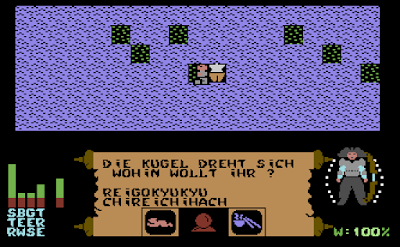 |
| Getting ready to teleport from a small island. |
 |
| Using the device while in a boat can cause some issues. |
You all laughed when I said I was using ArcGIS to annotate the map, but this allowed me to create a planar coordinate system and automatically calculate the coordinates of every city I'd already found. To visit a non-city location, I just had to hover my cursor over that part of the map to see the coordinates. Once you have the globe, you no longer have to worry about ships or any other mode of transportation; you can just warp to any point on the map. The only annoyance is that it takes a while to scroll through the eight syllables and set them, and enemies can appear and attack you while you're in the middle of it. Again, I cursed the developers for not just letting me use the damned number keys.
 |
| Automatically calculating the X and Y coordinates of each town in ArcGIS. |
Such an artifact made the flying horse superfluous, particularly since you have to use the globe to get to the horse in the first place. I found the pegasus in the middle of a mountain enclave on the north end of the center continent. Riding the horse is pretty cool, since you can see the entire landscape with no obstructions, but you can't do anything else while the horse is in flight, including responding to enemy attacks. Any use of the button causes the horse to try to land in its present location. The horse actually needs a landing strip of about 7 grassy squares to land safely. If he has less, he stops short and is injured, and you can't fly him again until you visit a horse doctor in one of the towns.
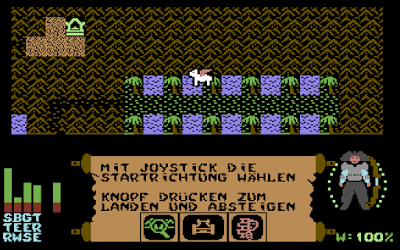 |
| Flying over a hidden mountain area that seems custom-made for landing a flying horse. |
Still, I used the horse for a while because when the globe told me it was out of energy, I didn't realize until later that it only meant for the day. I can also see where the horse would have been useful to a player not cheating by using a pixel-perfect map and a $5,000 GIS system, since it would be hard to land in a precise location with the paper map.
 |
| This is not the sort of place you want to get this message. |
Eventually, I had the dates associated with five of the sacred mountains. The sixth was supposed to be given to me by an ogre in Kami-no-mura, but owing to a bug, he didn't say what he was supposed to say. I looked up the answer on Thorsten's site. The game was taking place in 742, and the range of dates to visit the mountains went from 1 Rat 512 to 7 Horse 777. (One NPC gave me the number of the month but not the name; I had to look it up on an online calendar. I guess a 1988 player would have to go to the library.)
You use the Wheel of Time to make the journey, but the trick is that you have to be young or old enough to survive. You can't travel 150 years at a time. Starting was no problem, since I was only about 30, and the trip from 742 to 777 would only age me to 65. But to go back from there to the next date, 31 Boar 682, I had to be about 110 years old so that I could survive a trip 95 years in the past.
 |
| Setting the Wheel of Time. |
Thank god for the globe. If I'd had to sail to the Wheel and then to all the mountains, I would have gone crazy. Instead, I settled into an easy pattern: warp to a town where the physician offered an "aging" service and pay until I was old enough to survive, warp to the Wheel of Time, set it, then warp to the associated mountain to meditate and "consecrate" it. Six times in a row and I was done.
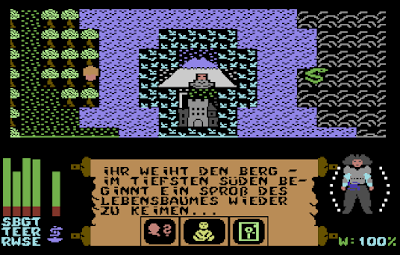 |
| I was never clear why I could only do this on specific dates. I probably missed a key NPC somewhere. |
Going back in time by more than 230 years didn't affect anything else. My flying horse and ships were just where I left them, the NPCs were still all alive and in place, and none of the lava receded. Thus, the whole thing was a bit silly. If Thorsten and Rüdiger want to re-make the game, I'd suggest that a series of quests that tie into the backstory and lore of the land would serve better. They had some interesting stuff about the emperor, princess, and wars between the gods that never amounted to anything but flavor.
Once I consecrated the mountains, I had to visit two temples that had offered nothing on previous visits. The first one told me to go to the south, on the border of the void, and search for a shrine at the end of the labyrinth.
 |
| "Greetings, blessed one!" |
Well, of course I didn't bother to go through the labyrinth. I just used the globe to go directly to the shrine. Visiting it caused a nearby bridge, which had previously ended in a blank wall, to extend. I wandered on a narrow path through the void--touching the walls brought instant death--until I arrived in the final city, Mokuteki.
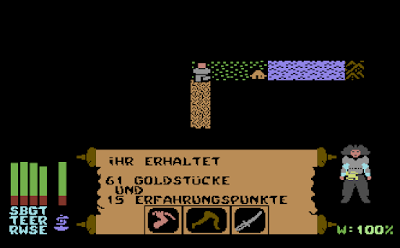 |
| Navigating the hidden path through the void. |
Mokuteki started by requiring me to swim a gap, then walk through a large lava pool, then hop in a ship to get around. If "Swim" and the Amulet of Hi weren't necessary before, they sure were here. The rest of the area was a bit obnoxious. I had to thread the boat through a long water maze in which touching the walls was instant death. In an era where I would have had to reload the entire game from scratch, I might have paid for a ticket to Germany just so I could have egged the developers' houses.
 |
| Well, this is going to be fun. |
For some reason, I had to buy a jin-no-dachi (a kind of magic sword) for 7,000 from a guy on an island. Fortunately, I had enough. I then had to give the weapon to a statue right next to the guy who sold it. This opened a hidden passage to the exit.
Outside was a small, mountain-enclosed lake with a skull in the center of an island. The first time I visited the skull, it told me that I had the "will but not the skill." Apparently, I hadn't visited all the Buddhas in the game, which is a prerequisite for leaving. I had to abandon the ship, warp back to the cities I'd missed, and answer a few final riddles. One of the Buddhas was in Mokuteki itself, behind an impenetrable wall, so I cast the "walk through wall" spell to get to him. I think this is the only necessary spell use in the game.
When I returned to the skull again, the endgame commenced. It switched to a side-view and depicted me emerging from the other side of the skull, a ship standing nearby. "You traverse the tunnel in the interior of the skull and reach the other shore," the game said.
 |
| I wonder if my slaves are still with me. |
I sailed the ship left until I made landfall in the same city where the game started. I sailed past a lighthouse and industrial wharf, docked, and walked past several buildings.
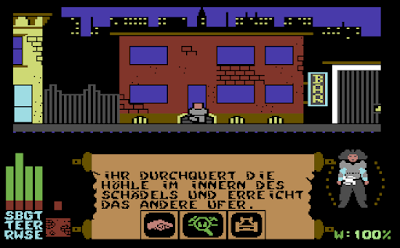 |
| Please let me in! |
Eventually, I made my way back to the museum where the game started. With nothing else to do, I walked through the pillars. "The circle closes," the text read. "The statues pull you into a world that you already know." And then it brought me to a "new game" screen. Toshiro is trapped in an endless loop. I guess that's supposed to be profound, but it strikes me as a little lazy.
 |
| The only winning move is not to play? |
In a GIMLET, I give the game:
- 5 points for the game world. The setting is original and the story is full of lore, but the player doesn't really engage with it, and nothing changes in the setting during gameplay, not even when you travel hundreds of years through time. The physical layout of the towns and continents are well-designed.
- 2 point for character creation and development. A very under-developed area. There's no creation at all, and combat is only rewarded with a titular rank. Your attributes increase by visiting Buddhas and demonstrating your knowledge of lore, but after a few of these visits, you really don't need any more (except as a requirement to win). Weapon skill increases are more useful, but you only get three per class of weapon.
- 4 points for NPC interaction. Perhaps the most important part of the game, hindered by a "stance" system that to a 1988 player would be like banging your head against a wall.
- 1 point for encounters and foes. The enemies in the game are completely un-interesting. They're not even much of a challenge.
- 2 points for magic and combat. Combat is like swatting at gnats around your head. You barely have to worry about it except that some enemies won't leave you alone. There are some interesting spells in the magic system, but it takes too long to acquire them, and as we've seen, they're mostly superfluous.
 |
| Using the only necessary spell to get me to the final Buddha. |
- 3 points for equipment. One weapon, one suit of armor, but there are some interesting artifact items.
- 4 points for economy. It's ruined a bit by the treasure chambers, where you can keep visiting to collect as much as you want. Eliminating those (or making them single-visit), boosting combat rewards, and lowering some costs would have created a more challenging system. There are quite a few things to buy with your money, though, and I thought the slaves, bath houses, and prostitutes were fun twists.
- 3 points for a main quest and some side-areas. "Get home" by itself is rarely a great quest. At least Dorothy made Oz a better place first.
- 3 points for serviceable graphics and sound, but as for the joystick-only interface: AAAAAAAAAAAAAA!
- 5 points for gameplay. The open world and nonlinearity are of course the strong parts of the game. Its difficulty is moderate enough, and it stands just short of the cusp of being too long.
That give us a final score of 32, just shy of what I would normally call "recommended," mostly for its lack of traditional RPG mechanics. A good RPG has to be more than going from city to city talking to people. Interesting things have to happen in between. But there is a definite allure to the open-world exploration, to finding that new city nestled in some remote valley, knowing it will be full of NPCs who fill in even more of the story. Of course, I had to painstakingly translate all those NPCs, reducing my own enjoyment significantly, but I tried not to let that affect my score.
 |
| The game uses all memory on a C64. |
The one review that I found in the October 1988 Power Play gives a pretty poor score--basically 36/100 if you average the categories. The reviewer praises the story and setting, offers amazement at the size (four disks!), and is happy to have an RPG in German. But he feels it is weak on graphics and sound and is particularly irked that enemies can still attack you while you're standing there waiting for the disk to transition you from wilderness to town. It frankly doesn't feel like he got very far into the game. He gets some facts wrong on the backstory, too. It's funny seeing him refer to Ultima--the oldest game only seven years old--as a "classic."
Thorsten Shur (now Sommermann) and Rüdiger Hoppe were friends as teenagers, and like many teenagers of the 1980s, they fell in love with Ultima II and Ultima III. They decided to try their own game, with updated technology, fusing an Ultima approach with their enthusiasm for the Bushido tabletop RPG setting, from which they took the character ranks and the name Nippon. I skimmed through the rulebook for Bushido, and it doesn't appear that Thorsten and Rüdiger adapted much else directly. Maybe some of the skills, weapons, monsters, and gods. The maps and location names are wholly original to the game.
 |
| This guy doesn't look like he's doing so well. |
The size of the game pushed the limits of the Commodore 64. I noted in a previous entry that the city of Ulti-Tori is shaped like Sosaria from Ultima III, but what I don't think I made clear is that it's also the same size as Sosaria; the entirety of Ultima III's outer world fit into one of Nippon's 40 cities. The game used all available 64kb of memory. To make such a large outer world possible, the disks are not organized into files but read block-by-block, which can cause some amusing errors if you put the wrong disk in the drive while traveling.
The authors found a publisher in Markt & Technik. The title song was written by Urs Heckman, who went on to form a company that makes software synthesizers. The game retailed for DM 40 (about $47 in USD today). Unfortunately, the company did little to promote the title and offered no support for translation or porting to other platforms. Rüdiger's best recollection is that it sold about 7000 copies.
 |
| This series of entries prompted Rüdiger to dig the old disks out of storage. The game was written in assembly code and assembled with a program written by the developers' friend. |
The bug I mentioned above frustrated a lot of players, apparently, and many of them wrote to the developers, who had included their addresses among the NPC dialogues in Funatabi. The authors made a version 2.0 that fixed the problem, but it wasn't published. It's probable that those who took the time to write were the only ones who won the game until the modern era.
Thorsten and Rüdiger both entered the information technology field but never worked on another game. They keep in touch and occasionally talk about reviving Nippon on another platform, or creating another Japanese RPG in a 3D environment. This is the sort of game that I wouldn't mind seeing re-made. Keep the same large, open-world approach, exotic setting, and interesting backstory and lore, but improve the combat tactics, character development, and inventory systems; offer a more complex interface; and better integrate the story with the quest. Maybe introduce some elements of caste and karma prevalent in Bushido that didn't make it into Nippon.
I want to thank the developers for visiting and corresponding with me, and Buck and Sebastian for helping me along. I started off thinking I wasn't going to finish this one and ending up glad that I did. We'll see if the same is true of the next 1988 offering: Ranadinn.
****
A couple of eliminations on my upcoming list:
1. I'm dismissing the upcoming The Scheme (1988) as a non-RPG. I'm not sure what "RPG elements" the various web sites that so categorized it think it has, but I watched a long video on the game and I don't see any. It's a side-scrolling action platformer.
2. Rogue Clone turns out to be so suited to its name that I don't even know if it's worth playing it as a separate title. Even if I do, it apparently dates from 1986, not 1988 as MobyGames has it, so it'll have to go on the "sweep up" list.
****
A couple of eliminations on my upcoming list:
1. I'm dismissing the upcoming The Scheme (1988) as a non-RPG. I'm not sure what "RPG elements" the various web sites that so categorized it think it has, but I watched a long video on the game and I don't see any. It's a side-scrolling action platformer.
2. Rogue Clone turns out to be so suited to its name that I don't even know if it's worth playing it as a separate title. Even if I do, it apparently dates from 1986, not 1988 as MobyGames has it, so it'll have to go on the "sweep up" list.
At All Articles Nippon: Won! (with Summary and Rating)
Thanks For Reading Nippon: Won! (with Summary and Rating) this time, hopefully it can benefit you all. alright, see you in another article post.
You are now reading the articlel Nippon: Won! (with Summary and Rating) with link address https://reviewgameupdate.blogspot.com/2018/03/nippon-won-with-summary-and-rating.html

0 Response to "Nippon: Won! (with Summary and Rating)"
Posting Komentar